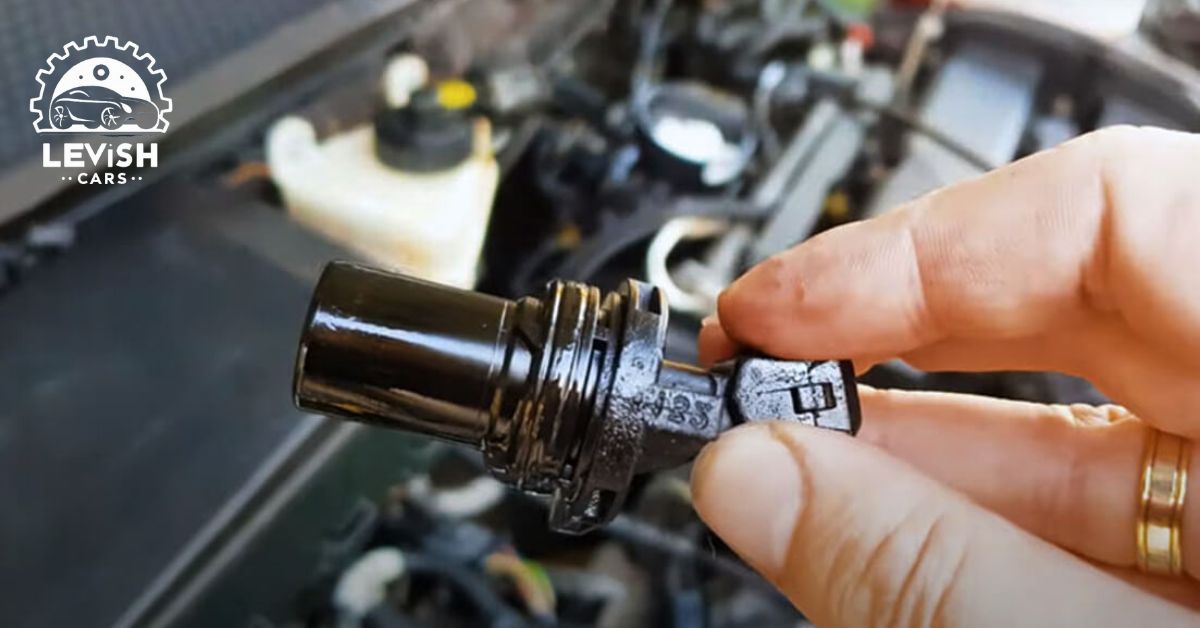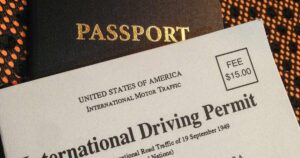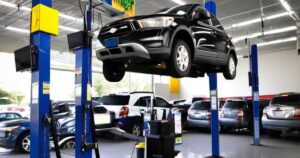When your crankshaft position sensor goes bad, your engine can start malfunctioning. This sensor is a key component that your engine control unit relies on for timing and combustion. Don’t panic if you notice symptoms of a failing sensor. There are some DIY temporary fixes you can try to get back on the road quickly.
Simple solutions like checking wiring connections, cleaning sensor mounts, and unplugging/reconnecting sensors may do the trick. These quick fixes target common issues like loose plugs, dirt buildup, and glitches in sensor operation. They are handy for restoring function temporarily until you can replace the faulty sensor.
Replacement is needed to permanently resolve crankshaft sensor problems. With some basic mechanical troubleshooting, you can diagnose issues and get your vehicle moving safely again. Temporary fixes help you limp along when dealing with a bad crankshaft position sensor.
To Understand the Temporary Fix for Crankshaft Position Sensor
What is Crankshaft Position Sensor?
The crankshaft position sensor is an electronic device that monitors the position and rotational speed of the crankshaft. It provides vital data to the vehicle’s engine control unit.
What Does the Crankshaft Position Sensor Do?
The key functions of the crankshaft position sensor are to detect the position of the crankshaft and calculate engine RPM. This data allows the engine control unit to regulate ignition timing and fuel injection.
Location of the Crankshaft Position Sensor

The crankshaft position sensor is typically located on the front of the engine block, near the crankshaft pulley. It monitors the position of the crankshaft through a reluctor ring.
What Does The Crankshaft Position Sensor Work?
The sensor works by detecting fluctuations in the reluctor ring’s magnetic field as the crankshaft rotates. This generates an electric signal that is sent to the ECU.
What is Crankshaft Sensor Position Code?
A crankshaft position sensor code indicates a problem or malfunction with the sensor. Common codes are P0335, P0336, P0337, and P0338.
Is There a Difference Between the Crankshaft Sensor and the Camshaft Sensor?
| Feature | Crankshaft Sensor | Camshaft Sensor |
| Location | Typically located near the crankshaft of the engine. | Usually positioned near the camshaft of the engine. |
| Function | Monitors the rotation speed and position of the crankshaft. | Monitors the rotation speed and position of the camshaft. |
| Signal Type | Generates a signal based on crankshaft rotation. | Generates a signal based on camshaft rotation. |
| Role in Engine Timing | Critical for determining the timing of piston firing in the combustion cycle. | Critical for synchronizing valve opening and closing with piston movement. |
| Contribution to Ignition | Provides information for ignition timing control. | Aids in fuel injection timing and valve timing control. |
| Failure Symptoms | Engine misfires, issues with starting the engine, and potential stalling. | Poor acceleration, difficulty in starting, and engine misfires. |
| Diagnosis | Tested with an oscilloscope or multimeter for signal consistency. | Diagnosed using similar tools, checking for signal irregularities. |
| Replacement Cost | Generally less expensive to replace. | May be more costly due to complexity and location. |
| Common Issues | Susceptible to damage from heat and vibration. | Prone to oil and debris contamination affecting performance. |
| Maintenance Importance | Regular maintenance is vital for optimal engine performance. | Regular checks and timely replacements contribute to engine efficiency. |
Quick Diagnosis for Crankshaft Position Sensor

A failing or faulty crankshaft position sensor can cause issues like difficult starting, stalling, misfiring, poor acceleration, and reduced engine power. The check engine light may come on with related trouble codes.
Sensor failure symptoms mainly occur at start-up or under load. Diagnosis involves checking connections, wiring, sensor resistance, and voltage signals. If faulty, the crankshaft position sensor needs to be replaced.
Check Engine Light
The check engine light coming on is one of the most common signs of crankshaft position sensor failure. Sensor related error codes will be stored by the ECU when the light turns on. Diagnostic trouble codes like P0335, P0315, and P0336 indicate crankshaft sensor issues.
Engine Stall
If the crankshaft position sensor fails, the engine may randomly stall while driving or restarting. This happens because improper sensor signals disrupt spark timing and fuel injection. Stalling is most likely to occur at higher speeds or with a hot engine.
Engine and Vehicle Shake Strongly
A malfunctioning crankshaft sensor can cause the engine to shake or vibrate intensely. Misfiring cylinders from improper timing cause extremely rough idling and loss of power. The vehicle may also shake as engine vibration transfers through drivetrain.
Misfire
Engine misfires are common crankshaft position sensor symptoms. Misfiring occurs when spark plugs fail to ignite fuel at the proper time. The sensor provides vital timing data, so crankshaft sensor errors can cause misfire in one or more cylinders.
Reduction In Engine Performance
As the crankshaft sensor fails, you may notice a significant reduction in engine power during acceleration. Sluggish acceleration and reduced power output result from poor combustion and timing issues caused by the malfunctioning sensor.
Unable to Start the Car
Complete crankshaft position sensor failure can make starting the engine impossible. If the sensor stops sending signals, the ECU won’t provide spark or inject fuel, preventing firing during cranking. The engine may turn over but won’t start without sensor input.
There Was a Rapid Increase in the Engine’s Resistance to Acceleration
Faulty crankshaft position sensor data can cause ignition and injection timing to be off. This leads to decreased engine response and increased resistance when trying to accelerate. Acceleration issues become worse as the sensor fails further.
The Poor Mileage
Incorrect fuel mixture and poor combustion from bad crankshaft sensor input reduces fuel economy. Mileage steadily declines as sensor performance gets worse over time. Replacing the faulty sensor can restore proper timing and engine efficiency.
What Codes Will a Bad Crankshaft Sensor Throw?
The engine control unit detects crankshaft sensor issues by monitoring signal voltage and plausibility. Common crankshaft position sensor codes are P0335, P0336, P0337, P0338, P0315, P1361, P1362. These indicate general crankshaft sensor failure, no signal at all, intermittent signal, or signal plausibility faults. Diagnostic trouble codes are an important clue pointing to crankshaft sensor faults.
What Causes Crankshaft Sensor to Go Bad?
Excessive heat, defective components, wiring issues, and normal wear over time can cause crankshaft position sensor failure. Prolonged exposure to high temperatures can damage the sensor’s internal components. Electrical issues like worn wiring insulation, shorts, opens, and resistance on the circuit can prevent proper sensor operation. Poor connections at the harness or sensor terminals can also cause sensor failure.
Overheating Engine
Excessive engine heat is a common cause of crankshaft sensor damage. High temperatures near the sensor can lead to internal component failure. Prolonged overheating causes the magnets to lose their magnetic field strength. Extreme heat also degrades the coil windings and connections.
Voltage and Wiring Faults
Electrical faults like loose wiring, corrosion, and improper supply voltage can lead to crankshaft sensor failure. Shorts, opens, and excessive resistance in the wiring harness interfere with sensor signals. Poor ground connections also disrupt the sensor, leading to internal damage over time.
Contamination
Oil sludge, dirt, and debris buildup on the crankshaft reluctor ring can prevent the sensor from reading properly. The contaminants interfere with the reluctor ring’s magnetic fields. Continued operation with contaminated components permanently damages the sensor.
Low-Quality Parts
Cheap aftermarket crankshaft position sensors often fail prematurely. Inferior materials, manufacturing flaws, and inadequate heat/vibration resistance cause early failure. Using the wrong sensor for a particular vehicle can also lead to rapid failure due to improper fitment.
How to Check if Crankshaft Position Sensor Is Bad?

Check for diagnostic trouble codes: Codes like P0335, P0336, P0337 indicate issues with the crankshaft sensor.
Check sensor connector and wiring: Look for damage, corrosion, loose connections, etc. that could cause sensor failure.
Perform visual inspection: Look for signs of damage to the sensor housing, loose mounting, degraded wiring insulation.
Do resistance test: Use a multimeter to check that sensor resistance values are within specification.
Monitor sensor data: With a scan tool, check that the sensor is producing voltage signals that change with crankshaft speed. Signal dropouts point to sensor failure.
How to Test Crankshaft Sensor?
Check sensor resistance with a multimeter to see if it matches specifications. Monitor sensor voltage signals with a scan tool while cranking the engine to check for issues. Inspect sensor wiring, connectors, and housing for any signs of damage or corrosion.
How to Test the 2-wire Crankshaft Position Sensor
- Unplug the sensor and check resistance between the two wires – should match spec
- Reconnect sensor and check for AC voltage during cranking – should see ~0.5V
- Inspect sensor housing and wires for damage or oil contamination
- Clear any Diagnostic Trouble Codes and retest after repair
How to Test the 3-wire Crankshaft Position Sensor
- Check resistance between all three wire pairs – resistance values should match specs
- With sensor plugged in, look for voltage on signal wire during cranking
- Voltage should fluctuate between ~0.5V – 4.5V
- Inspect sensor mounting, housing, and wiring condition
- Retest after addressing any wiring faults or replacing damaged sensor
The key things to check are sensor resistance when unplugged, and fluctuating AC voltage when the sensor is connected and engine is cranking. This will confirm whether the sensor is functioning correctly.
Temporary Fix for Crankshaft Position Sensor
Here is a summary on the temporary fix for a failed crankshaft position sensor:
- Check sensor wiring and connectors for any issues. Fix loose or corroded connections, damaged insulation, etc.
- Clean sensor mounting area on engine and the sensor itself to remove any dirt, oil or debris. Contamination can affect sensor operation.
- Make sure sensor bolt and mounting bracket are tight and secure. A loose sensor can cause signal problems.
- Consider bypassing the sensor temporarily using a jumper wire if engine will not start. This allows continued driving but engine may run poorly.
- Replace sensor as soon as possible. The fixes above are only temporary – a bad crankshaft sensor needs to be replaced for proper engine operation.
- Diagnose other problems like worn timing chain that could be causing sensor failure. A new sensor may fail again if underlying issue not fixed.
The goal of the temporary fix is to get the vehicle driving until the crankshaft position sensor can be replaced with a new one. But sensor replacement is the ultimate solution.
Shut The Vehicle Down, Let The Vehicle Cool Down
Letting the engine cool down allows inspection and testing of the crankshaft sensor when the engine is not hot. Heat can damage the sensor and make testing difficult. Cooling down may also allow the sensor to temporarily reset.
Disconnect the Crank Shaft Position Sensor
Unplugging the sensor connector allows you to check for issues with sensor wiring like loose connections, corrosion, or wire damage. Disconnecting it can also reset the sensor.
Filling up Fuel
A full tank of fresh fuel helps provide maximum voltage to the sensor from the fuel pump. Old, contaminated fuel can cause sensor problems. New fuel improves engine performance.
Check The Wiring Harness
Inspect wiring for fraying, stripped insulation, loose connectors, or corrosion. Faulty wiring prevents proper sensor operation. Repair any wiring issues before reconnecting.
Restart the Engine
Restarting the engine tests if disconnecting and reconnecting the sensor resolved any connection issues. The vehicle may start and run better with sensor reconnected.
Can You Fix a Crankshaft Position Sensor?
The crankshaft position sensor cannot be repaired, only replaced. But you can temporarily resolve related wiring faults and connection issues to restore proper sensor function until the sensor itself is replaced.
The Pros and Cons of Temporary Fixes for Crankshaft Position Sensor Issues
Should I Fix Or Replace Crankshaft Position Sensor?
- Fixing may resolve wiring or connector issues temporarily
- But cannot repair faults with the sensor itself
- Replacement ensures putting in a fully functional new sensor
- Recommended to just replace the sensor if diagnosed as faulty
Cons of Fixing a Crankshaft Position Sensor
- Does not address root problem if sensor is bad
- Further sensor damage can occur
- Engine performance issues will persist
- More repairs needed down the road
Pros of Crankshaft Position Sensor Replacement
- Confirms the sensor is in good working order
- Restores proper engine operation
- Eliminates driveability and performance problems
- No more repeated repairs needed
How to Repair a Crankshaft Position Sensor?
- The sensor itself cannot be repaired, only replaced
- But you can fix related wiring harness issues
- Check for corrosion, damage, loose wires
- Ensure good electrical connections
Is It Possible to Replace a Crankshaft Position Sensor?
- Yes, the crankshaft sensor is designed to be replaced
- Match new sensor to your vehicle’s specs
- Disconnect old sensor, install new one
- Relearn procedure may be required
How to Replace Crankshaft Sensor?
Here are 4 steps to replace a crankshaft position sensor:
- Disconnect the battery: This allows safe sensor removal and prevents electrical shorts.
- Locate the sensor: Follow wires from ECU to find it, usually at front of engine near crank pulley.
- Remove old sensor: Disconnect wiring harness and remove mounting bolt to take out old sensor.
- Install new sensor: Carefully connect wiring to new sensor, tighten mounting bolt, ensure proper alignment with reluctor ring.
When installing the new sensor:
- Compare the old sensor to new one to ensure correct replacement.
- Clean any dirt/debris from the sensor area on the engine.
- Don’t overtighten mounting bolt – follow torque specs.
- Make sure the electrical connector clicks into place.
After installing, reconnect the battery and test engine operation. The ECU may need relearning to work with new sensor.
Is Hard To Replace Crankshaft Position Sensor?
Replacing the crankshaft position sensor is usually a straightforward process on most vehicles. Locating and accessing the sensor can be tricky on some tightly-packed engines. But with proper tools and precautions, the average DIYer can replace the sensor in under an hour.
How Much Does It Cost to Replace a Crankshaft Sensor?
The replacement parts cost is typically $25-$75 for the sensor. Add another $100 or so for tools if you don’t have them. Shop rates run $80-$150 per hour, so total cost at a mechanic is $200-$350 depending on labor time.
How Long Does It Take to Replace a Crankshaft Sensor?
The labor time to replace the sensor ranges from 1-3 hours in most cases. More time may be needed on difficult to access sensors. But when done properly, the sensor can usually be changed over in under 2 hours.
What to Do After Replacing a Crankshaft Sensor?

Steps after sensor replacement include clearing any codes, road testing, ECU reset to relearn, and maintenance to prevent future issues. Verify sensor operation before normal use of vehicle.
Eradicate Error Codes
Clear any existing crankshaft sensor related trouble codes from the ECU’s memory after completing the replacement. This gives you a clean slate to monitor for new codes.
Conduct a Test Drive
Take the vehicle for a brief test drive allowing the ECU to fully relearn the new sensor’s signals under normal operating conditions.
Reset the ECU
Some vehicles require you manually reset the ECU to allow relearning of the crankshaft sensor. This completes the programming process.
Sustain Regular Maintenance
Follow recommended service intervals to change oil, check transmission fluid, replace air filters to maintain proper engine function and prevent sensor issues.
Preventing Future Issues
Use high quality parts, keep fluids changed, clean debris from sensor area, and avoid overheating engine to prevent repeat failure of new sensor.
Frequently Asked Questions
Can You Drive a Car Without a Crankshaft Sensor?
No, the engine won’t run without a crankshaft sensor.
How to Start a Car with a Bad Crankshaft Sensor?
You may be able to bypass it with a jumper wire to start temporarily.
Will Driving with Bad Crankshaft Position Sensor Damage the Engine?
Yes, it can lead to timing, performance, and mechanical issues.
How Long Can I Drive with a Bad Crankshaft Position Sensor?
Only drive long enough to take the car for sensor replacement service.
Can a Crankshaft Sensor Be Bypassed?
Yes, it’s possible but not recommended except in an emergency to get home or to a shop.
Final Thoughts
Dealing with a failed crankshaft position sensor can certainly be frustrating. But don’t worry, with some basic mechanical skills and troubleshooting techniques, you can often get your engine up and running again temporarily.
The key is to methodically check all sensor connectors, wiring, and mounting points before assuming the sensor itself is bad. Cleaning connections, securing loose wires, and unplugging/reconnecting the sensor can surprisingly do the trick sometimes.
While these quick fixes are handy to get you out of a bind, it’s critical to properly diagnose and replace the crankshaft position sensor as soon as possible.
Related:
How To Trick A Mass Air Flow Sensor?
How To Start Car With Bad Ignition Switch?

Hey there! I have 5 years of experienced repairing all makes and models. Specializes in engine diagnostics, brake repair, electrical systems, and teaching DIY maintenance tips. Passionate about keeping cars running safely.








